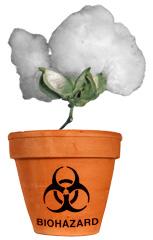It hangs from clothing racks across the country. It’s displayed in storefronts along Park Avenue and Rodeo Drive. It’s worn both on the runway and on the sidewalk.
It’s cotton.
But before it’s even sent to the factory for production — before its fate is roughly sketched into a design — it starts as a small, fuzzy seed. Planted in dry soil, it sits, about to endure the long, hot growing season.
As it breaks through the topsoil and stretches toward the sky, farmers spray the plant with pesticides which, according to Keith Edmisten, a crop science professor and extension cotton specialist, gives the plant a bad reputation.
“Cotton has often been considered a crop that requires high levels of pesticide,” he wrote in an e-mail. These pesticides can seep into the soil and into underground water deposits. Runoff water can also gather residual pesticides and transfer them to larger bodies of water, such as streams and lakes.
However, he wrote that the methods with which farmers now harvest the crop reduce pesticide use, which lessens corrosive environmental effects.
“This has been reduced dramatically in North Carolina over the past 20 years due to the eradication of boll weevil, the invention of less toxic pesticides such as pyrethroids, seed treatments and genetically engineered cotton,” he wrote. “The same would not be true for many other cotton producing areas outside the U.S.”
And although the crop has also been given a bad reputation, he said, because of its impact on the environment, Edmisten wrote this could be due to misunderstanding. “Cotton also got a bad name over the years with many people believing that cotton ‘robbed’ the soil,” he wrote. “What was really happening was that there was a lot of preseason and in-season tillage cotton production in the past which allowed topsoil to erode from fields. This was especially true in the Piedmont.”
Now, according to Edmisten, farmers take care to protect against erosion. “Farmers today use much less tillage and soil erosion has been reduced dramatically,” he wrote.
Thus, following suit with other green revolutions, cotton production in some places is becoming more organic.
“What you are allowed to use on organic cotton may have little to do with the actual toxicity of the product and often does not make a lot of sense [to use],” he wrote.
The plant itself, he said, is not really any worse for the environment than other crops.
“It uses less nitrogen and phosphorous than corn and other grass crops,” Edmisten wrote.
Organic cotton is grown using low-impact methods and materials — ones that replenish soil fertility and reduce the use of both toxic pesticides and fertilizers, according to the Organic Trade Association’s Web site.
This sustainability is something Meena Menon, a journalist who has worked with The Times of India, addressed in her book, Organic Cotton: Reinventing the Wheel.
Menon focused on harmful effects cotton has had on Indian land and water. According to Menon, changing to organic cotton is necessary and beneficial.
She wrote that data from 1997 to 2001 showed that farmers obtained optimum yields when both fertilizer and organic manure was used.
And organic farming, she wrote, is not just about the plants.
“Organic farming is much more than reverting to one’s roots or the days of traditional farming,” Menon said. “It is a struggle for a more just and sustainable future.”
Organic cotton
A definitionOrganic cotton is grown using methods and materials that have minimal impact on the environment. Organic production systems replenish and maintain soil fertility, reduce the use of toxic and persistent pesticides and fertilizers and build biologically diverse agriculture. Third-party certification organizations verify that organic producers use only methods and materials allowed in organic production.
Global productionFrom 2000 to 2001, international production was grown in more than 12 countries and accumulated to slightly more than 14 million pounds. This represents about 0.03 percent of worldwide cotton production. Turkey and the United States were the leading producers of organic cotton, followed by India, Peru, Uganda, Tanzania, Egypt, Senegal, Israel, Greece, Benin and Brazil.
Organic cotton in AmericaFarmers in four states harvested 6,814 bales (3,270,720 pounds) of organic cotton from 5,550 acres during 2004. This is an increase from the 4,628 bales harvested from 4,060 acres in 2003. Texas continues to lead the United States in organic cotton production, with limited acreage also planted in California, New Mexico and Missouri.
The apparel industryApparel companies are developing programs that either use 100 percent organically grown cotton, or blend small percentages of organic cotton with conventional cotton in their products. There are a number of companies driving the expanded use of domestic and international organic cotton.
Products made using organic cottonAs a result of consumer interest, organic cotton fiber is used in everything from personal care items, home furnishings, children’s products, clothes and even stationary and note cards. Organic cottonseed is used for animal feed, and organic cottonseed oil is used in a variety of food products, including cookies and chips.
SOURCE: ota.com/organic/mt/organic_cotton.html








